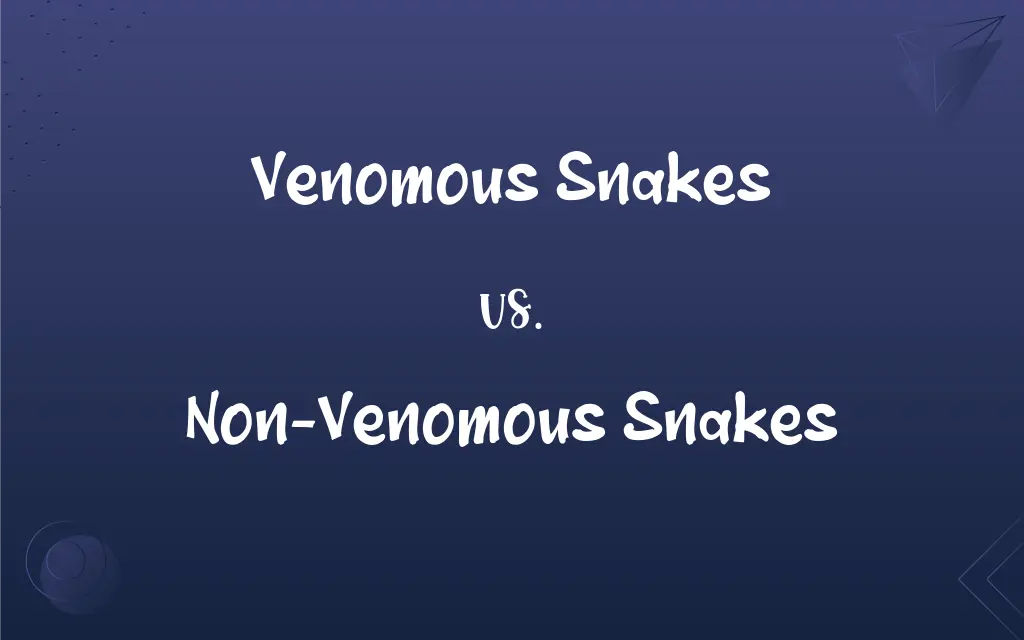Venomous Snakes vs. Non-Venomous Snakes: What's the Difference?
Edited by Harlon Moss || By Janet White || Published on February 12, 2024
Venomous Snakes are snakes that produce venom to immobilize or kill prey. Non-Venomous Snakes are snakes that do not produce venom and use constriction or other means to subdue prey.

Key Differences
Venomous snakes are equipped with specialized glands that produce venom, a toxic substance used for prey immobilization and defense. Non-venomous snakes, in contrast, lack these venom glands and rely on other methods, like constriction, to capture and kill their prey.
The fangs of venomous snakes are adapted for venom delivery, often being hollow or grooved to channel venom into their prey. Non-venomous snakes usually have teeth that are not specialized for venom delivery, as they do not produce venom.
Bites from venomous snakes can be dangerous to humans and other animals due to the presence of toxins that can cause significant harm or even be fatal. Bites from non-venomous snakes are usually less dangerous but can still cause injury through puncture wounds.
In ecosystems, venomous snakes play a role in controlling prey populations and as apex predators in some environments. Non-venomous snakes also contribute to ecological balance by preying on various animals but use different hunting strategies.
Identification of venomous snakes often involves recognizing specific features like head shape, eye shape, and color patterns, which can differ significantly from those of non-venomous snakes.
ADVERTISEMENT
Comparison Chart
Venom Glands
Present
Absent
Fang Type
Specialized for venom delivery
Not specialized for venom
Danger from Bite
Potentially fatal due to venom
Less dangerous, no venom
Hunting Method
Use venom to immobilize prey
Use constriction or other methods
Identification
Specific head and eye shapes, color patterns
Different head shape, lack of certain venomous markers
ADVERTISEMENT
Venomous Snakes and Non-Venomous Snakes Definitions
Venomous Snakes
Snakes using venom for defense and subduing prey.
Venomous snakes like vipers use their venom to quickly immobilize their prey.
Non-Venomous Snakes
Snakes lacking venom glands and venomous fangs.
The corn snake is a popular type of non-venomous snake kept as a pet.
Venomous Snakes
Snakes that possess venom glands for injecting venom.
The rattlesnake is a well-known type of venomous snake found in the Americas.
Non-Venomous Snakes
Snakes that pose minimal risk to humans from their bites.
Bites from non-venomous snakes like the common garter snake are usually harmless.
Venomous Snakes
Species of snakes with specialized fangs for venom injection.
Many venomous snakes have hollow fangs that function like hypodermic needles.
Non-Venomous Snakes
Snakes safe for human handling due to lack of venom.
Non-venomous snakes are often found in educational settings for demonstrations.
Venomous Snakes
Snakes that pose a risk to humans and animals due to their venomous bites.
In Australia, venomous snakes such as the taipan are among the most dangerous.
Non-Venomous Snakes
Species of snakes that rely on physical strength or stealth to hunt.
The garter snake, a common non-venomous species, hunts small amphibians and insects.
Venomous Snakes
Reptiles capable of delivering venom through bites.
The cobra is a venomous snake famous for its hood and potent venom.
Non-Venomous Snakes
Reptiles that subdue prey without the use of venom.
Non-venomous snakes like pythons use constriction to overpower their prey.
FAQs
Are non-venomous snakes dangerous to humans?
Generally, they are less dangerous, but their bites can cause injury or infection.
What makes a snake venomous?
A venomous snake has specialized glands that produce venom, used to immobilize or kill prey.
Can venomous snake bites be fatal?
Yes, bites from some venomous snakes can be fatal due to the toxins in their venom.
Can non-venomous snakes be pets?
Many non-venomous snakes are kept as pets due to their minimal risk.
How can I identify a venomous snake?
By specific features like head shape, eye shape, and color patterns.
Do all venomous snakes have the same type of venom?
No, the composition of venom varies among different venomous snake species.
Can venomous snakes control the amount of venom they inject?
Many venomous snakes can control their venom output.
Are there venomous snakes in urban areas?
Venomous snakes can sometimes be found in urban areas, though it's less common.
Do non-venomous snakes have fangs?
They have teeth, but not specialized fangs for delivering venom.
What habitats do venomous snakes prefer?
Venomous snakes inhabit a variety of environments, from deserts to rainforests.
How do non-venomous snakes capture their prey?
They use methods like constriction or overpowering with strength.
What is the purpose of venom in snakes?
Venom is used for defense and to immobilize or kill prey.
Are anti-venom treatments available for all venomous snakes?
Anti-venoms are available for many, but not all, venomous snakes.
Can a non-venomous snake bite cause an allergic reaction?
While rare, allergic reactions to non-venomous snake bites can occur.
How do I treat a venomous snake bite?
Seek immediate medical attention and avoid home remedies.
What should I do if I encounter a non-venomous snake?
Keep a safe distance and avoid disturbing it.
How do non-venomous snakes defend themselves?
Through biting, fleeing, or camouflaging.
Do non-venomous snakes play a role in pest control?
Yes, they help control populations of rodents and insects.
Can venomous snakes be trained or tamed?
Venomous snakes are wild animals and are not suitable for training or taming.
How do I prevent snake bites when outdoors?
Wear protective clothing, watch your step, and avoid reaching into unseen places.
About Author
Written by
Janet WhiteJanet White has been an esteemed writer and blogger for Difference Wiki. Holding a Master's degree in Science and Medical Journalism from the prestigious Boston University, she has consistently demonstrated her expertise and passion for her field. When she's not immersed in her work, Janet relishes her time exercising, delving into a good book, and cherishing moments with friends and family.
Edited by
Harlon MossHarlon is a seasoned quality moderator and accomplished content writer for Difference Wiki. An alumnus of the prestigious University of California, he earned his degree in Computer Science. Leveraging his academic background, Harlon brings a meticulous and informed perspective to his work, ensuring content accuracy and excellence.







































































